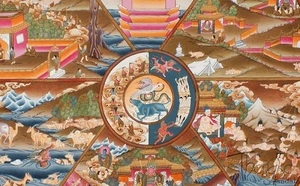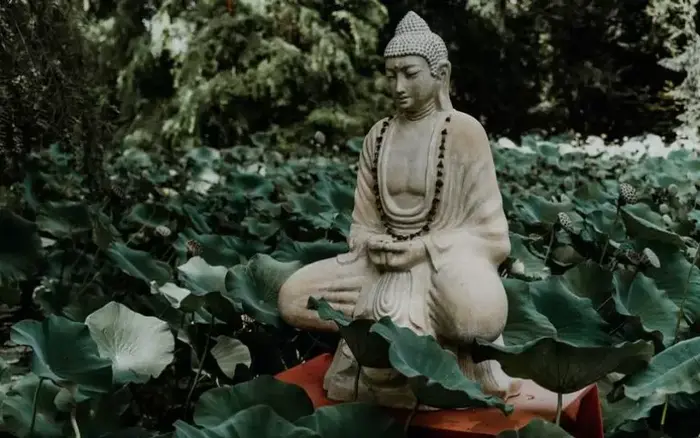In Buddhism, reincarnation — often described as rebirth — is a pillar that supports not only the understanding of the universe and human existence, but also guides the spiritual path towards liberation and Nirvana.
Adverts
Just like other Eastern spiritual traditions, which have reincarnation at their core, presenting a fascinating paradigm of continuity of consciousness beyond physical death.
This spiritual focus unfolds into a rich tapestry of stories, metaphors, and teachings that resonate with individual searches for meaning, purpose, and transcendence.
Through the centuries, teachers and practitioners have shared experiences of profound insights, expanded compassion, and a more intimate understanding of the interconnectedness of all life forms, highlighting how Buddhist practices cultivate a fuller, more connected consciousness, setting the stage for a greater rebirth. auspicious.
This continuous dialogue between the individual and the infinite, between the being and the whole, highlights reincarnation not as a mere succession of lives, but as an evolutionary journey towards wisdom and liberation.
The Nature of Renaissance in Buddhism
Buddhism understands rebirth as a continuous process of deaths and rebirths, known as Samsara. This cycle of existence is fueled by the actions (karma) carried out, the effects of which manifest themselves throughout successive lives.
Liberation from this cycle, achieved by the state of enlightenment (Nirvana), constitutes the ultimate goal of Buddhist practice. This concept is intrinsically linked to the law of karma, which states that good actions lead to favorable rebirths, while negative actions result in challenging future existences.
However, Buddhism not only prescribes an ethical path of conduct, but also emphasizes the importance of wisdom and correct understanding of reality as a means of transcending Samsara.
Therefore, meditative practice and the development of compassion are fundamental for purifying the mind and accumulating merits, essential for the journey towards enlightenment.
Through diligent practice of the Noble Eightfold Path, Buddhists aspire to break the shackles of desire and ignorance, thereby achieving final liberation from the cycle of rebirth..
The Concept of Non-Self and the Continuity of Consciousness
Central to Buddhist doctrine is the concept of Anatta (Non-Self), which refutes the existence of a permanent and unalterable self. Contrary to notions of an eternal reincarnating soul, Buddhism proposes that what is transmitted is a continuous flow of consciousness, conditioned by past actions, but without an immutable essence.
This flow of consciousness is seen as a succession of interconnected mental and physical states, evolving based on actions (karma) and their consequences.
This view implies that, rather than a fixed identity or soul that transmigrates intact from one life to another, there is a continuous chain of causation and transformation, without a central or permanent “self.”
Anatta's understanding challenges the human tendency towards attachment and identification with the ego, promoting a release from the limitations imposed by such identifications.
This teaching not only clarifies the nature of rebirth, but also serves as a foundation for practices of detachment and compassion, encouraging practitioners to transcend the perception of separation between self and others, recognizing the interconnectedness of all beings.
Karma: The Law of Cause and Effect
Meditation occupies a central place in Buddhist practice, functioning as a means of cultivating mindfulness, deep understanding and internal purification. Through meditation, practitioners develop the ability to observe and transform the patterns of thought and behavior that perpetuate the cycle of rebirth.
This practice allows us to dive into the present moment, unveiling the ephemeral nature of phenomena and weakening the bonds of attachment and aversion that bind us to Samsara. By cultivating positive mental states and reducing emotional disturbances, meditation provides fertile ground for spiritual growth.

Practitioners learn to face pain and pleasure with equanimity, recognizing the impermanence of all experiences.
This process not only prepares the individual to face life's challenges with serenity, but also paves the way for the ultimate realization of Nirvana, the state of total liberation from suffering and cycles of rebirth.
The Path to Liberation in Buddhism
The Noble Eightfold Path is the essence of Buddhist teaching, providing a complete guide to ending suffering and liberation from the cycle of rebirth. This path is divided into three main categories: wisdom (Prajña), ethics (Sila) and concentration (Samadhi).
Under wisdom lie right understanding, which encompasses understanding the Four Noble Truths and the impermanent nature of existence, and right thinking, which encourages intentions of renunciation, non-malevolence, and non-violence.
Ethics is represented by right action, right speech and right way of life, promoting behaviors that sustain social and personal harmony, such as refraining from harming living beings, speaking the truth and adopting a way of life that does not harm others.
Concentration involves right effort, right attention and right concentration, focusing on developing the mind to achieve deep meditative states and insight spiritual.
By cultivating these qualities and practices, followers of Buddhism can purify their minds, overcome negative karma, and advance on the path to enlightenment and an end to the cycle of suffering..
Meditation: Transformation Tool
Meditation occupies a central place in Buddhist practice, functioning as a means of cultivating mindfulness, deep understanding and internal purification. Through meditation, practitioners develop the ability to observe and transform the patterns of thought and behavior that perpetuate the cycle of rebirth.
Furthermore, meditative practice in Buddhism goes beyond simple observation, acting directly at the root of mental afflictions — such as desire, aversion and ignorance — that sustain Samsara.
Through specific techniques, such as Vipassana meditation (insight) and the practice of Metta (loving kindness), qualities such as compassion, equanimity and discerning wisdom are cultivated.
These meditative practices not only alleviate immediate suffering, but also set the stage for deeper transformation, guiding the practitioner toward enlightenment and ultimate freedom from the cycle of rebirth.
By integrating meditation into their daily lives, Buddhists strengthen their ability to live with greater awareness and intention, redefining their relationships with the world and themselves in more harmonious and liberating ways.
Conclusion: Reincarnations and Buddhism
The doctrine of reincarnation in Buddhism offers a deeply optimistic view of human existence. Rather than locking individuals into an unchanging destiny, Buddhism emphasizes the capacity for change, growth, and liberation through right understanding, ethical practice, and spiritual development.
In this context, each life is seen as a precious opportunity to advance on the path of enlightenment, towards ultimate freedom from the cycle of birth, death and rebirth.
This transformative perspective not only infuses each moment with meaning and purpose, but also strengthens the interconnection between all beings, reinforcing the importance of compassion and selfless action.
By understanding that our actions echo beyond the boundaries of current life, we are encouraged to live with greater mindfulness and kindness, aware of the lasting impact we can have on the world and future cycles of existence.
This approach to life and death elevates the spiritual journey to an act of love and service, highlighting the unlimited potential for personal growth and transformation.



